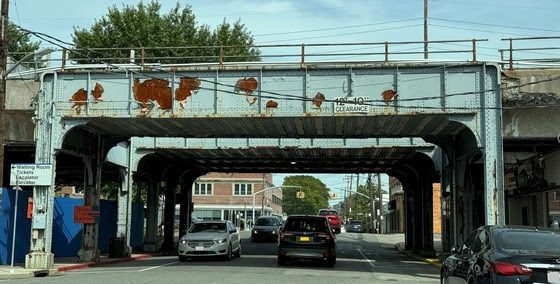
By Hank Russell
The Office of Nassau County Comptroller Elaine Phillips recently completed a review of all 58 Long Island Rail Road (LIRR) stations in the county and found that the stations and infrastructure have fallen into disrepair.
Site visits revealed peeling paint, decaying concrete, pitted steel and filthy conditions at some of the county’s busiest LIRR stations, according to the comptroller’s office — despite the county paying the Metropolitan Transportation Authority (MTA) more than $100,000 a day (or $36.5 million a year) to use, maintain and operate these stations.
Further, county residents are charged nearly $100 a year to the MTA whenever they register a car, renew a driver’s license, record a mortgage and pay sales tax. Each year, Nassau taxpayers send more than $137 million to the MTA, not counting train fares.
The stations with the worst conditions include Floral Park, Valley Stream, Long Beach and Rockville Centre. Also topping the list for rider dissatisfactions were Glen Cove, Island Park and Bellerose. Overall, the problems at these stations include:
- pigeon droppings, smells of urine and garbage
- crumbling concrete platforms, peeling paint and rusted and pitted steel, poor lighting and outdated infrastructure
- reports of homeless individuals, drug use, and lack of security presence
- lack of waiting rooms and bathrooms or limited access to those that do exist
- limited available parking and poor conditions in the parking lot (for example, potholes)
The review also took into account responses from 935 LIRR riders who completed a survey, with 457 of the respondents taking the opportunity to offer optional comments.
Among the open-text comments, approximately 85% were negative, according to the comptroller’s office. The most common complaints concerned pigeon infestations and related filth, and riders’ frustration with not having access to an indoor waiting area or restrooms at their train stations.
Among the 58 LIRR stations in Nassau County, 43 have an indoor waiting room and 42 have bathrooms; however, most are locked before the evening rush hour ends, and roughly half are closed on weekends. Evening and weekend riders are left with no protection from the elements and no bathrooms.
“As Nassau County comptroller, I am focused on ensuring that taxpayer dollars are spent efficiently and effectively, so when I heard from numerous constituents from across the County that there were problems at our Long Island Rail Road stations, I had to look into it,” said Phillips.
Phillips reiterated that Nassau pays the MTA $36.5 million a year to have them maintain the stations, but the agency failed to do so. “Where is all of this money going if our LIRR stations are not painted, cleaned or maintained regularly?” said Phillips.
Phillips said, when this question was sent to the MTA in a formal letter back in March, the MTA answered with a verbose response that was filled with information about the MTA, but did not answer the question.
Long Island Life & Politics reached out to the MTA on this. “This is a political audit that wasn’t shared with LIRR before it was blasted to the media,” said MTA spokesperson David Steckel in a statement. “The LIRR is running the best service in its history and the recently approved 2025-2029 $68.4 billion capital program is the most ambitious investment [in] service reliability ever made.”

